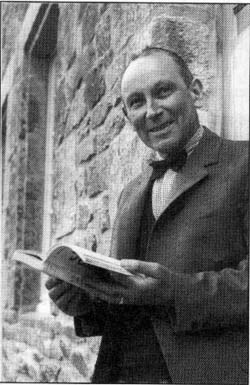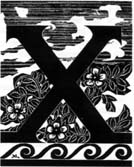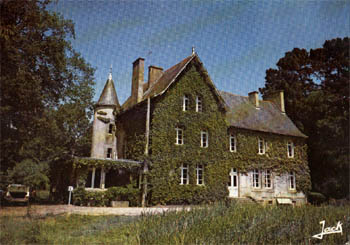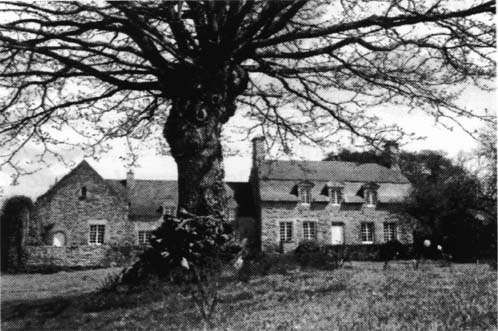

 AVIER de LANGLAIS
AVIER de LANGLAIS
LANGLEIZ 1906-1975
Painter and Writer
Painter and writer : these two words sum up a life's work of such extraordinary richness ; but for someone, gifted with so many talents, perhaps the word Artist would be more appropriate.
Born in Sarzeau (Morbihan) Xavier de Langlais was always very attached to the countryside, rural life and its people those Bretons from whom he has gathered their songs, depicted their labours and recorded the design of their traditional clothes. Descended from an old family, established in Brittany for five hundred years, he was always going to preserve his roots ; but he was also strong-minded enough to break out of his family environment to pursue his vocation of painting.
The first indication of where his life would lead is to be found in his admiration for his uncles. These were : René du Guermeur, his mother?s brother, a very attractive cavalry officer, who died from his wounds in the 1914-18 War ; Elie de Langlais, his father's brother, mayor of Sarzeau and « conseiller général » , open to all, generous towards others, who spoke a little Breton. But Xavier de Langlais also inherited the qualities of his great-grandfather, Amédé de Francheville, a cultivated man of wide-ranging interests and a talented amateur painter.
 Cohanno neve
Cohanno neve
His childhood was spent between Cohanno in the commune of Surzur (Morbihan) and Argelès-Gazost (Hautes-Pyrénées), where his parents were attracted by the sunnier winters. Because of this, his education was undertaken by tutors. Amongst the latter was Abbot Carazé, a vicar at Argelès, who had a strong influence on his cultural development, evoking in him an interest in literature and a love of the Basque Country. Despite all this, Xavier de Langlais missed Brittany.
Very early on, Xavier de Langlais developed a desire to draw. But he needed the support of his mother and of his aunt before he could get his father?s permission to enroll in the School of Fine Art at Nantes (1922) and after- wards at Paris (1926 -1928). It was during his time in Paris that distance made him think more of Brittany : he began to use his spare time to teach himself Breton from books. Then it was time for military service in the cavalry at Fontainebleau. Luckily there was the forest, horses and friends ; he finished as sergeant-major, which was not bad for an artist !
Returning to Brittany and living with his parents at Cohanno, Xavier de Langlais embarked on his career as a painter. It was the period of the « Seiz Breur » (Seven Brothers), a group of Breton artists encompassing a whole variety of skills. He was closely associated with this group to which was entrusted the design of the Brittany pavilion at the 1937 Paris International Exhibition. (See the note « Seiz Breur » after the Biography.) With the architect, James Bouillé, he founded the Studio of Christian Art.
There were only nine years left before the next outbreak of war for Xavier de Langlais to make his name. This pre-war period was full of exciting events : there was a great renewal of art in Brittany ; the Church, still wealthy, was actively building and embellishing. He threw himself headlong into his work, built up projects, experimented with different techniques and secured orders despite his young age. In 1931 he married Annick Gazet du Chatelier and had four children. She was his support throughout his life and continued to publicize his work after his death. But then came the 1939-45 war with Xavier de Langlais' call-up : a strange war, which kept him inactive at Vannes. Horses no longer being enough to keep him busy, he yearned for new horizons, perhaps Syria, but that was denied to him. Demobilised in 1940, he was faced with harsh reality : no more orders.
France had to endure five years which threw it back to the beginning of the century . Cars were requisitioned, further electrification ceased, everything disintegrated, horses and traps were back. There was no room for artists.
In 1941 Xavier de Langlais decided to move to Rennes where he became the literary and artistic critic on the newspaper « la Bretagne ». His time at Rennes was a stage of prime importance in his life ; he arranged for his family to join him. Even though he had never forgotten his Rhuys peninsula, it was in Rennes that his work as a painter blossomed.
With the end of the war he took advantage of the new freedom of movement to immerse himself in his Brittany,
these journeys were to produce some concentrated artistic work : an exhibition of charcoal drawings and of paintings of the Monts d?Arrée ; a series of drawings of Island of Sein, its views and its inhabitants ; an album of St Malo devastated by the war. These would be his last works influenced by realism ; henceforth he would be inspired by his imagination.
Faced with the uncertainties of an artist's life, in 1948 Xavier de Langlais accepted the post of Professor of Drawing at the Rennes School of Fine Art. These evening classes left him plenty of time to pursue his own work :
- frescoes and Stations of the Cross,
-paintings and drawings,
-engravings and illustrations for books,
-books in French and Breton,
-experiments on the technique of painting in oils.
Being a convinced regionalist, Xavier de Langlais was involved in the Breton movement. He played a decisive part in unifying Breton spelling and helped in the spreading of books written in Breton. He was president of the Celtic Circle of Rennes and co-founder of « the Camp » of Breton-speakers ; he was tireless in his support of the Breton cause. His work was uninterrupted throughout the morning until midday ; from that hour onwards his door was always open. Then he was busy offering advice to some and resolving differences for others . He was a tireless worker, with an iron will, whose affable appearance could be deceptive. This « dreamer » revealed himself to be a man of action.
The life of Xavier de Langlais was a continuous seeking of perfection :
-a mystic exploration in his literary work,
-a religious probing in his painting,
-research into the technique of perfection of form and of support (the material base of a picture).
His desire for perfection made him prefer his more recent pictorial works to the detriment sometimes of his earlier work ; quite often he even destroyed old canvasses or re-used the backs.
Despite his attachment to Brittany Xavier de Langlais wanted his work to have a universal appeal. It was in his writings that he came closest to this aim. His « Technique of Oil-painting » has been tranlated into Dutch and Japanese. His « Tales of King Arthur » belong to the universal theme of the Arthurian legend ; it has received the accolade of the Academie Française. Unfortunately his books have not been tranlated into English.
His achievements as a painter have been rewarded with the Blumenthal Prize in 1939, and the New York Prize in 1962. Thanks to the purchase of his collection of engravings by the Museum of Brittany in Rennes, his work as an illustrator can be admired by the public. His frescoes and murals can be inspected in religious buildings, for the most part open to the public, and also in the Museum of Léon at Lesneven.
Xavier de Langlais died in Rennes, at sixty-nine, after a well-filled life, but one which was not wholly complete. He would have liked to have translated into Breton the rest of the books of the « Tales of King Arthur ». He leaves a memory of somebody ever young : the privilege of those who leave us too soon. To him who said : « This anxiety which I bear, will only cease on my death », may he have found lasting peace.
Tugdual de Langlais
Translation: Terence O'Hara, M. A. Oxon
If you want to discover some other sites:
Cohanno kozh
Xavier de Langlais Manor's restored by himself

Xavier de LANGLAIS
and the « SEIZH BREUR » (Seven Brothers)
Born in Brittany, Xavier de Langlais was imbued with the Breton spirit. All his life he was an apostle and a militant one, too of Breton culture.
Xavier de Langlais began by becoming a member of the « Seizh Breur » (Breton for « Seven Brothers »). Seven, magic number, but also « la Pléiade bretonne » (See Note 1). In fact there were to be more than seven. This Breton artistic movement was founded in 1923 by Jeanne Malivel and René-Yves Creston. These enthusiastic young artists wanted to re-create Breton artistic expression, at a time when the word Breton still made people think of « Bretonneries » - the hat, the breeches and the draughts of cidre, typical of Théodore Botrel, and so often disparaged.
This point of view was shared by numerous talented young artists wished to get away from the classic path traced by their predecessors favouring a quest for authenticity. They wished to renew Breton art in its entirety and to adapt it to modern times whilst still retaining its special character. At the same time they aimed to replace an art rooted in the past with an art evolving and developing in the Celtic spirit. Members of this cultural movement were Jeanne Malivel, who was of prime importance, James Bouillé, Xavier Haas, Georges Robin and many others. Xavier de Langlais was one of them, being the youngest of the team : he was eighteen when he joined.
This movement of « the Seizh Breur » had a marked influence on Xavier de Langlais' engraving, a facet of his artistic expression less well known to the general public. It is also interesting to note how homogenous was the manner of engraving of these Breton artist. For my part, I think it is not too exaggerated to say that, in engraving at least, these artists formed a veritable School, like the Impressionists of Pont-Aven in the domain of painting. On several occasions, these engravers worked together, notably in the publication of a series on Breton saints, each artist being responsible for a certain number of engravings. This work was remarkable, for, though each artist had worked in his own style, the whole creation was completely coherent. As I have already indicated, that perfectly illustrates my analogy with a School of artists.
To be involved in the Seven Brothers was to share a spirit of the soul, to have a passion to escape from the beaten path ; it was a search for authenticity. This source of inspiration had a bearing upon Xavier de Langlais' painting. He too refused to engage in « Bretonneries ». That was the basis, in my opinion, of the moral constraints, to which he bound himself from his earliest days. Paradoxically, he also wanted to give his painting a strictly neutral cachet which would have a common appeal for everybody. This was to avoid the criticisms made against so many of his predecessors and contemporaries. Perhaps one can explain this infatuation with painting of scenes from the past, of which my father was a bit disdainful, by the rapid pace of the evolution of our civilisation. Thus it transpires that these paintings have become valuable evidence of a by-gone age ; paintings in which it is often difficult to detect the talent and the personality of the individual artist. These numerous painters of the first half of the twentieth century would doubtless have remained completely unknown without this revolution of modern life.
However, there was nobody more Breton than my father. For the reasons which I have just given, he did not want his paintings to be stamped with his origins ; his Brittany is rarely present in this aspect of his life's work. I can confirm that he did it with conscious aforethought. To sum up : that is the answer I received on the day when I put to him the question which was intriguing me. He wanted to leave a record as a classical artist and not simply as a witness of his times.
Xavier de Langlais was in complete harmony with James Bouillé : together they founded « l'Atelier Breton d'Art Chrétien » (The Breton Studio of Christian Art). Their most complete achievement was the building of the Chapel of St Joseph's College in Lannion, where they were responsible for every detail of the planning even including the religious vestments. It was Madame de Planhol who designed all the ornaments and cloths.
James Bouillé died in the chaos of 1945 as a result of a perfectly unjustified imprisonment. The Breton Studio of Christian Art did not outlive its founder. Xavier de Langlais was to be the last president of the Seven Brothers. But the heart had gone out of the movement : it died of its own accord, shortly afterwards.
Gaëtan de LANGLAIS
Translation : Terence O'HARA, M. A. Oxon
Note: la Pléiade Name taken by a group of sixteenth century French writers and poets, seven in number, as in the group of stars, the Pleiades.
Bibliography:


Sous la direction de D. Delouche
Editions Coop Breizh
Daniel Le Couédic et J.-Y. Veillard